Research on Optimization Method of Evaporation Duct Prediction Model
Abstract
:1. Introduction
2. Related Theories and Models
2.1. Monin Obukhov’s Similarity Theory
2.2. Sea Surface Roughness
- The COARE3.0 sea surface roughness parameterization scheme serves is the foundational parameterization scheme for the COARE model and can be represented as [11]where is the Charnock coefficient, a = 0.011, b = 0.007, c = 0.018, u is wind speed. However, this parameterized scheme does not consider the effect of waves on roughness.
- The TY01 sea surface roughness parameterization scheme is a dimensionless roughness parameterization scheme based on a wave slope, in which the sea surface roughness is closely related to wave height [28]:where a = 1200, b = 4.5, is the significant wave height, is peak wavelength, is wave slope and v is the kinematic viscosity.
- The Oost sea surface roughness parameterization scheme considers both wave age and friction velocity, and its roughness can be expressed as a function of wave age and friction velocity [29]:where , , a = 45, b = 4.5, is the wave period, is the phase speed of dominant waves.
- The COARE 3.5 sea surface roughness parameterization scheme is based on the COARE 3.0 sea surface roughness parameterization scheme which modifies the wind speed dependence of the Charnock parameter; it extends the limited range of the parameterization scheme wind speed to 0~20 m/s [12]:where , a = 0.017, b = 0.005.
- The Edson sea surface roughness parameterization scheme subdivides the water depth [30]:where , , a = 0.091, b = 2.In deep sea,In shallow sea,where is the depth of the water. If in deep sea, = 1, if in shallow sea, = 0.
- The Porchetta sea surface roughness parameterization scheme finds that the roughness length is related to the angle between the wind direction and the wave direction; the functional form is [31]where a = 20, b = 0.45, c = 3.8, d = 0.32.
2.3. Universal Stability Function
- BH91 is a summary of the work of Beljaars and Holtslag [13] on surface flux observations and modelling of the MESOGERS-84 experiment in Cabauwin, the Netherlands and the south of France, which offers a new functional form under stable conditions:where w = 5, r = 0.35, t = 10.
- CB05 was studied on the performance of the Monin–Obukhov similarity theory under the stable condition by Cheng and Brutsaert [14], during the Cooperative Atmosphere-Surface Exchange Study-99 (CASES-99) and the following expression was obtained:where a = 6.1, b = 2.5, c = 5.3, d = 1.1.
- G07 is a dataset collected by Grachev [15] during the SHEBA for a wide range under the stable conditions. It includes strongly stable conditions. New and functions are derived from this dataset, covering the full range of :where .
- The BYC model improves the validity of the Monin–Obukhov similarity theory under the low wind speed conditions. The function is [3]where a = 5.
- The COARE 3.0 model, COARE 3.5 model and MM5REV model functions arewhere .
- The BYC function is [3]where .
2.4. Evaporation Duct Prediction Model
3. Evaporation Duct Prediction Model Based on Optimization Algorithm
3.1. The Optimization Algorithm
3.2. Particle Swarm Optimization Algorithm
3.3. Simulated Annealing Algorithm
3.4. Optimization Algorithm for Evaporation Duct Prediction Model
4. Experiment
4.1. Shipboard Data Acquisition Experiment
4.2. Shipboard Data
4.3. Evaporation Duct Prediction Model Selection
4.4. Parameters to Be Optimized
4.5. Optimization Results
5. Summary
6. Discussion
Author Contributions
Funding
Data Availability Statement
Acknowledgments
Conflicts of Interest
References
- Xu, L.; Yardim, C.; Haack, T. Evaluation of COAMPS Boundary Layer Refractivity Forecast Accuracy for 2–40 GHz Electromagnetic Wave Propagation. Radio Sci. 2022, 57, e2021RS007404. [Google Scholar] [CrossRef]
- Yang, C.; Shi, Y.; Wang, J.; Feng, F. Regional Spatiotemporal Statistical Database of Evaporation Ducts Over the South China Sea for Future Long-Range Radio Application. IEEE J. Sel. Top. Appl. Earth Obs. Remote Sens. 2022, 15, 6432–6444. [Google Scholar] [CrossRef]
- Jiang, H.; Li, J. Location privacy-preserving mechanisms in location-based services: A comprehensive survey. ACM Comput. Surv. CSUR 2021, 54, 1–36. [Google Scholar] [CrossRef]
- Ding, J.; Fei, J.; Huang, X.; Cheng, X.; Hu, X.; Ji, L. Development and Validation of an Evaporation Duct Model. Part I: Model Establishment and Sensitivity Experiments. J. Meteorol. Res. 2015, 29, 467–481. [Google Scholar] [CrossRef]
- Yang, S.; Li, X.; Wu, C.; He, X.; Zhong, Y. Application of the PJ and NPS Evaporation Duct Models over the South China Sea (SCS) in Winter. PLoS ONE 2017, 12, e0172284. [Google Scholar] [CrossRef] [PubMed]
- Chai, X.; Li, J.; Zhao, J.; Wang, W.; Zhao, X. LGB-PHY: An Evaporation Duct Height Prediction Model Based on Physically Constrained LightGBM Algorithm. Remote Sens. 2022, 14, 3448. [Google Scholar] [CrossRef]
- Shi, Y.; Yang, K.; Yang, Y.; Ma, Y. A New Evaporation Duct Climatology over the South China Sea. J. Meteorol. Res. 2015, 29, 764–778. [Google Scholar] [CrossRef]
- Zhang, Q.; Yang, K.; Shi, Y. Spatial and Temporal Variability of the Evaporation Duct in the Gulf of Aden. Tellus A Dyn. Meteorol. Oceanogr. 2016, 68, 29792. [Google Scholar] [CrossRef]
- Hong, F.; Zhang, Q. Time Series Analysis of Evaporation Duct Height over South China Sea: A Stochastic Modeling Approach. Atmosphere 2021, 12, 1663. [Google Scholar] [CrossRef]
- Jiang, Y.; Yao, X.; Zhang, Y. An Evaporation Duct Height Estimation Algorithm Based on Deep Neural Networks. J. Phys. Conf. Ser. 2022, 2224, 012020. [Google Scholar] [CrossRef]
- DeMott, C.A.; Klingaman, N.P. Atmosphere-ocean coupled processes in the Madden-Julian oscillation. Rev. Geophys. 2015, 53, 1099–1154. [Google Scholar] [CrossRef]
- Deike, L. Mass transfer at the ocean–atmosphere interface: The role of wave breaking, droplets, and bubbles. Annu. Rev. Fluid Mech. 2022, 54, 191–224. [Google Scholar] [CrossRef]
- Tangang, F.; Chung, J.X. Projected future changes in rainfall in Southeast Asia based on CORDEX–SEA multi-model simulations. Clim. Dyn. 2020, 55, 1247–1267. [Google Scholar] [CrossRef]
- Nadeau, D.F.; Pardyjak, E.R. Similarity scaling over a steep alpine slope. Bound.-Layer Meteorol. 2013, 147, 401–419. [Google Scholar] [CrossRef]
- Grachev, A.A.; Andreas, E.L. The critical Richardson number and limits of applicability of local similarity theory in the stable boundary layer. Bound.-Layer Meteorol. 2013, 147, 51–82. [Google Scholar] [CrossRef]
- Woolway, R.I.; Maberly, S.C. Climate velocity in inland standing waters. Nat. Clim. Chang. 2020, 10, 1124–1129. [Google Scholar] [CrossRef]
- Jiménez, P.A.; Dudhia, J.; González-Rouco, J.F.; Navarro, J.; Montávez, J.P.; García-Bustamante, E. A Revised Scheme for the WRF Surface Layer Formulation. Mon. Weather Rev. 2012, 140, 898–918. [Google Scholar] [CrossRef]
- Tian, B.; Liu, Q.; Lu, J.; He, X.; Zeng, G.; Teng, L. The Influence of Seasonal and Nonreciprocal Evaporation Duct on Electromagnetic Wave Propagation in the Gulf of Aden. Results Phys. 2020, 18, 103181. [Google Scholar] [CrossRef]
- Frederickson, P.; Alappattu, D.; Wang, Q.; Yardim, C.; Xu, L.; Christman, A.; Fernando, H.J.S.; Blomquist, B. Evaluating the Use of Different Flux-Gradient Functions in NAVSLaM During Two Experiments. In Proceedings of the 2018 IEEE International Symposium on Antennas and Propagation & USNC/URSI National Radio Science Meeting, Boston, MA, USA, 8–13 July 2018; pp. 885–886. [Google Scholar]
- Shami, T.M.; El-Saleh, A.A. Particle swarm optimization: A comprehensive survey. IEEE Access 2022, 10, 10031–10061. [Google Scholar] [CrossRef]
- Hashizume, T.; Ying, B.W. Challenges in developing cell culture media using machine learning. Biotechnol. Adv. 2023, 70, 108293. [Google Scholar] [CrossRef]
- Wang, B.; Wu, Z.-S.; Zhao, Z.; Wang, H.-G. Retrieving Evaporation Duct Heights from Radar Sea Clutter Using Particle Swarm Optimization (PSO) Algorithm. Prog. Electromagn. Res. M 2009, 9, 79–91. [Google Scholar] [CrossRef]
- Wang, Q.H.; Bedoya-Pinto, A. The magnetic genome of two-dimensional van der Waals materials. ACS Nano 2022, 16, 6960–7079. [Google Scholar] [CrossRef] [PubMed]
- Mohseni, N.; McMahon, P.L. Ising machines as hardware solvers of combinatorial optimization problems. Nat. Rev. Phys. 2022, 4, 363–379. [Google Scholar] [CrossRef]
- Tirkolaee, E.B.; Goli, A.; Ghasemi, P. Designing a sustainable closed-loop supply chain network of face masks during the COVID-19 pandemic: Pareto-based algorithms. J. Clean. Prod. 2022, 333, 130056. [Google Scholar] [CrossRef] [PubMed]
- Zhao, X.; Huang, X. Remote Sensing of Atmospheric Duct Parameters Using Simulated Annealing. Chin. Phys. B 2011, 20, 099201. [Google Scholar] [CrossRef]
- De Leeuw, G.; Andreas, E.L. Production flux of sea spray aerosol. Rev. Geophys. 2011, 49. [Google Scholar] [CrossRef]
- Warner, J.C.; Armstrong, B. Development of a coupled ocean–atmosphere–wave–sediment transport (COAWST) modeling system. Ocean. Model. 2010, 35, 230–244. [Google Scholar] [CrossRef]
- Ricchi, A.; Bonaldo, D. Simulation of a flash-flood event over the Adriatic Sea with a high-resolution atmos-phere–ocean–wave coupled system. Sci. Rep. 2021, 11, 9388. [Google Scholar] [CrossRef]
- Edson, J.B.; Jampana, V.; Weller, R.A.; Bigorre, S.P.; Plueddemann, A.J.; Fairall, C.W.; Miller, S.D.; Mahrt, L.; Vickers, D.; Hersbach, H. On the Exchange of Momentum over the Open Ocean. J. Phys. Oceanogr. 2013, 43, 1589–1610. [Google Scholar] [CrossRef]
- Porchetta, S.; Temel, O.; Muñoz-Esparza, D.; Reuder, J.; Monbaliu, J.; van Beeck, J.; van Lipzig, N. A New Roughness Length Parameterization Accounting for Wind–Wave (Mis)Alignment. Atmos. Chem. Phys. 2019, 19, 6681–6700. [Google Scholar] [CrossRef]
- Eriksen, M.; Lebreton, L.C. Plastic pollution in the world’s oceans: More than 5 trillion plastic pieces weighing over 250,000 tons afloat at sea. PLoS ONE 2014, 9, e111913. [Google Scholar] [CrossRef] [PubMed]
- Stevens, R.J.; Meneveau, C. Flow structure and turbulence in wind farms. Annu. Rev. Fluid Mech. 2017, 49, 311–339. [Google Scholar] [CrossRef]
- Fausto, R.S. Programme for Monitoring of the Greenland Ice Sheet (PROMICE) automatic weather station data. Earth Syst. Sci. Data 2021, 13, 3819–3845. [Google Scholar] [CrossRef]
- Sauer, J.A. The FastEddy® resident-GPU accelerated large-eddy simulation framework: Model formulation, dynamical-core validation and performance benchmarks. J. Adv. Model. Earth Syst. 2020, 12, e2020MS002100. [Google Scholar] [CrossRef]
- Zhou, W.; Shen, M.; Zhang, Y.; Wu, D.; Zhu, D. Offshore Surface Evaporation Duct Joint Inversion Algorithm Using Measured Dual-Frequency Sea Clutter. IEEE J. Sel. Top. Appl. Earth Obs. Remote Sens. 2022, 15, 6382–6390. [Google Scholar] [CrossRef]
- Wang, Z.H.; Chang, C.C. Optimizing least-significant-bit substitution using cat swarm optimization strategy. Inf. Sci. 2012, 192, 98–108. [Google Scholar] [CrossRef]
- Bell, M.L.; Catalfamo, C.J. Post-acute sequelae of COVID-19 in a non-hospitalized cohort: Results from the Arizona CoVHORT. PLoS ONE 2021, 16, e0254347. [Google Scholar] [CrossRef]
- Mirjalili, S.; Mirjalili, S.M.; Lewis, A. Grey Wolf Optimizer. Adv. Eng. Softw. 2014, 69, 46–61. [Google Scholar] [CrossRef]
- Emary, E.; Zawbaa, H.M.; Hassanien, A.E. Binary Grey Wolf Optimization Approaches for Feature Selection. Neurocomputing 2016, 172, 371–381. [Google Scholar] [CrossRef]
- Ma, H. An Analysis of the Equilibrium of Migration Models for Biogeography-Based Optimization. Inf. Sci. 2010, 180, 3444–3464. [Google Scholar] [CrossRef]
- Niccolai, A.; Grimaccia, F.; Mussetta, M.; Pirinoli, P.; Bui, V.H.; Zich, R.E. Social Network Optimization for Microwave Circuits Design. Prog. Electromagn. Res. C 2015, 58, 51–60. [Google Scholar] [CrossRef]
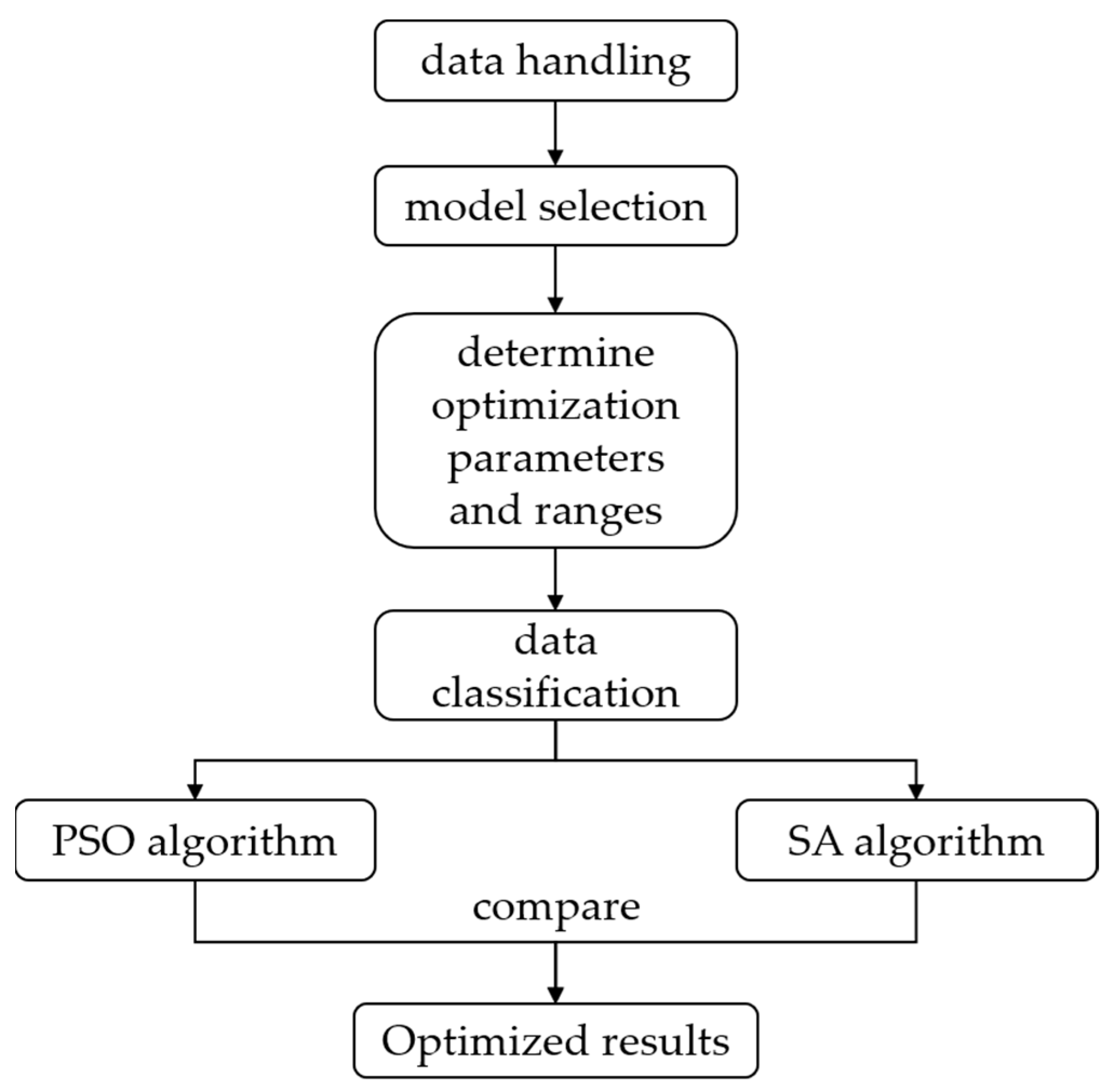
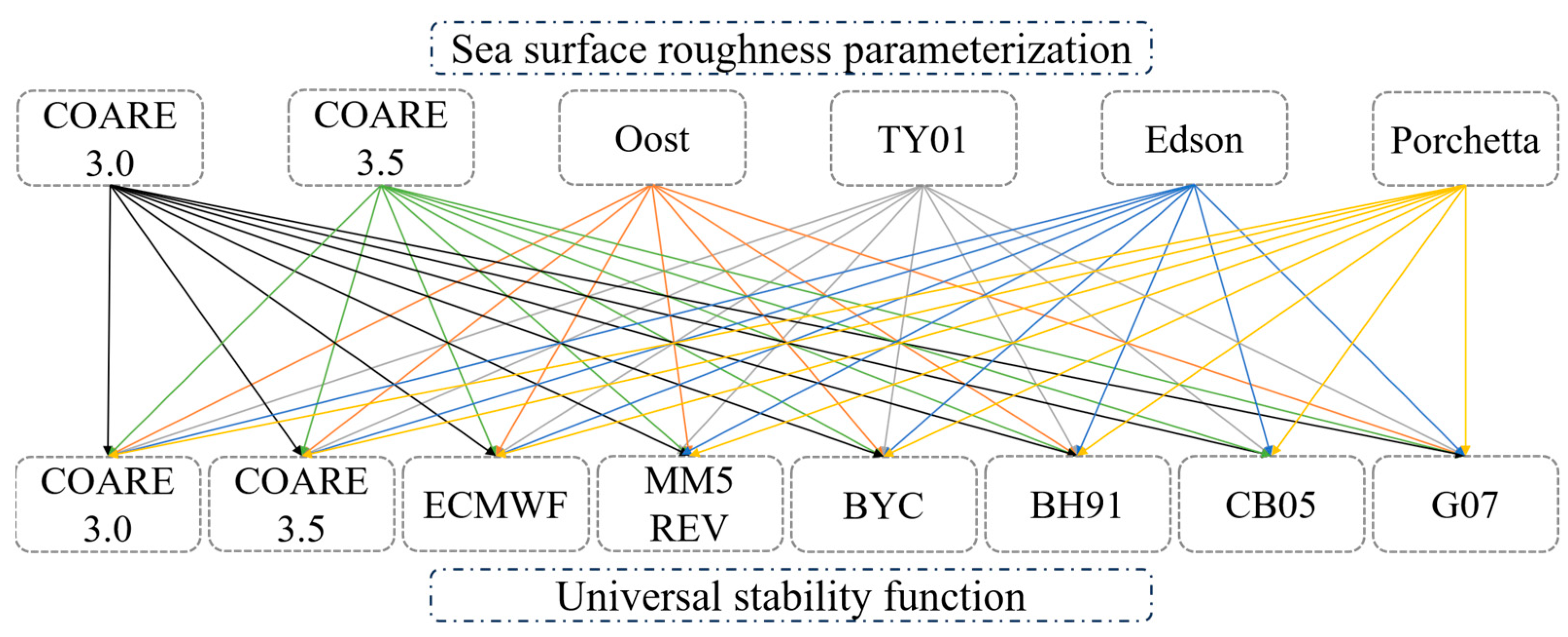

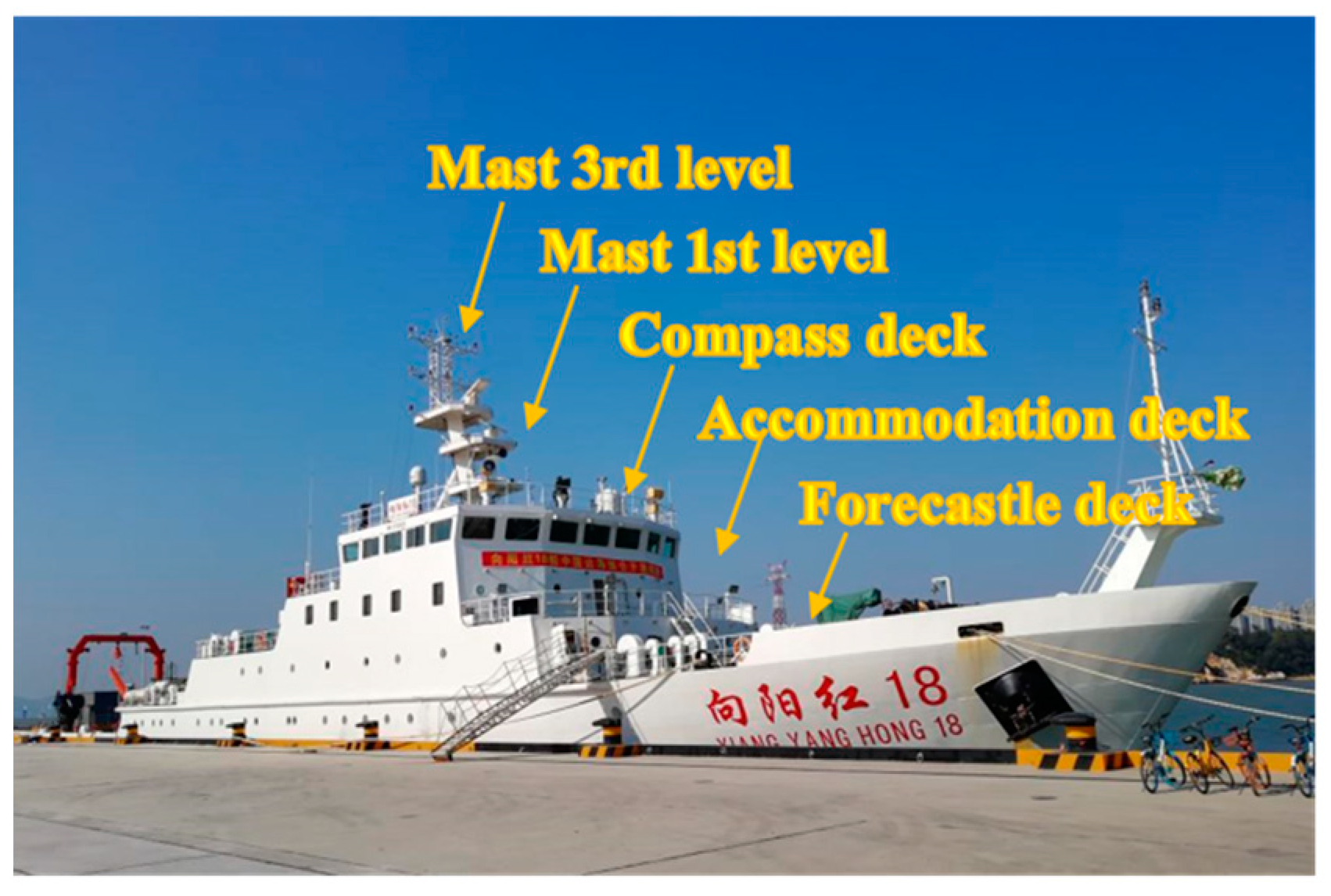


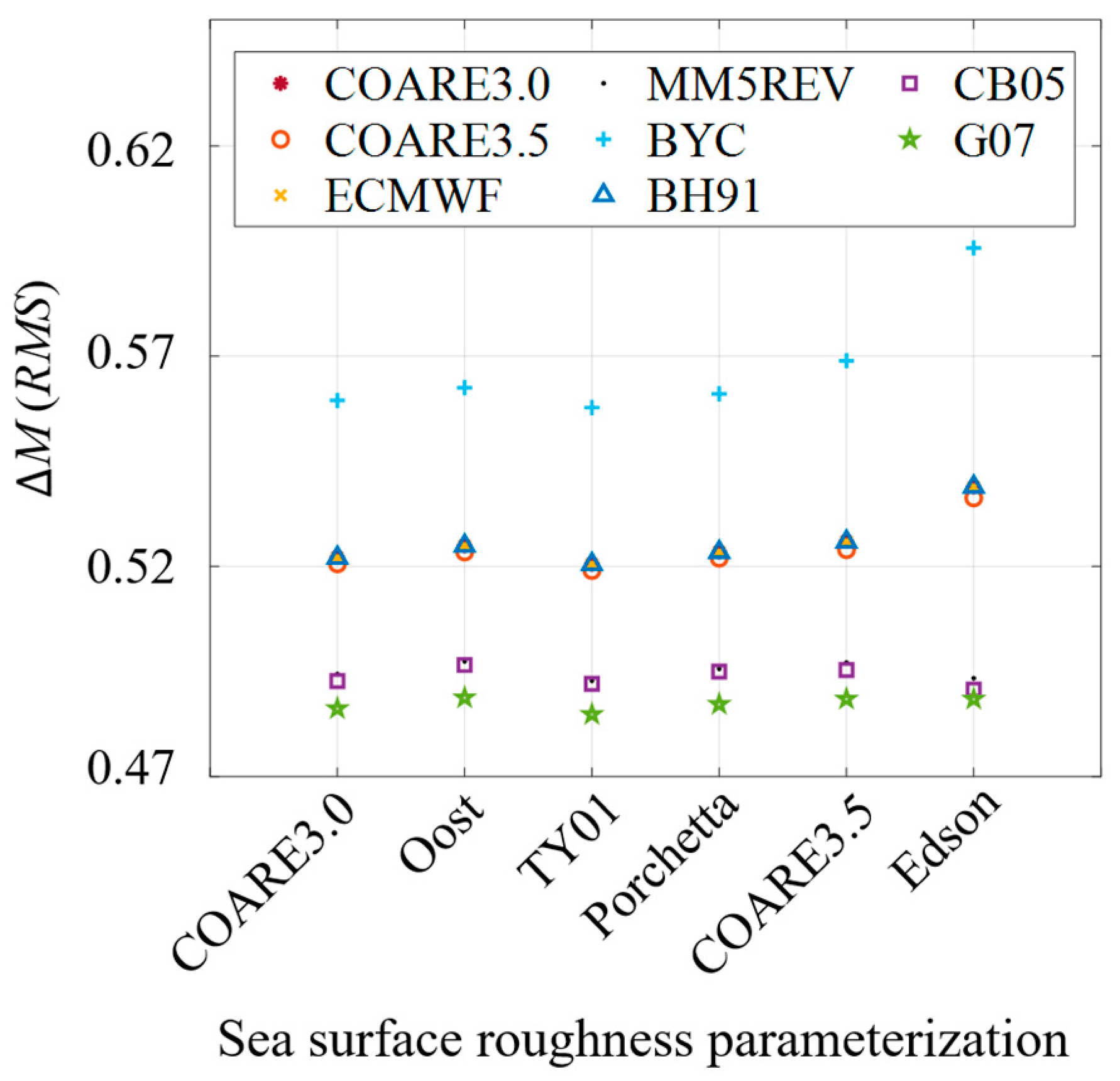


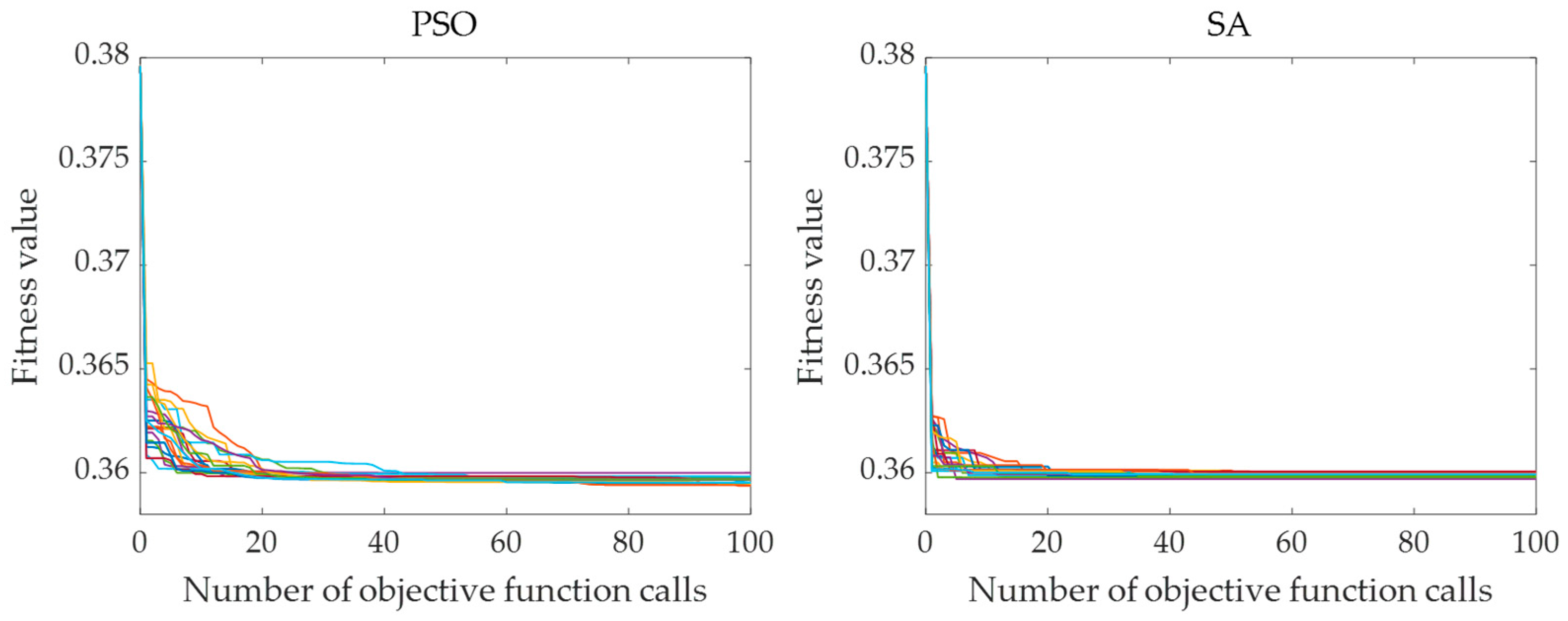
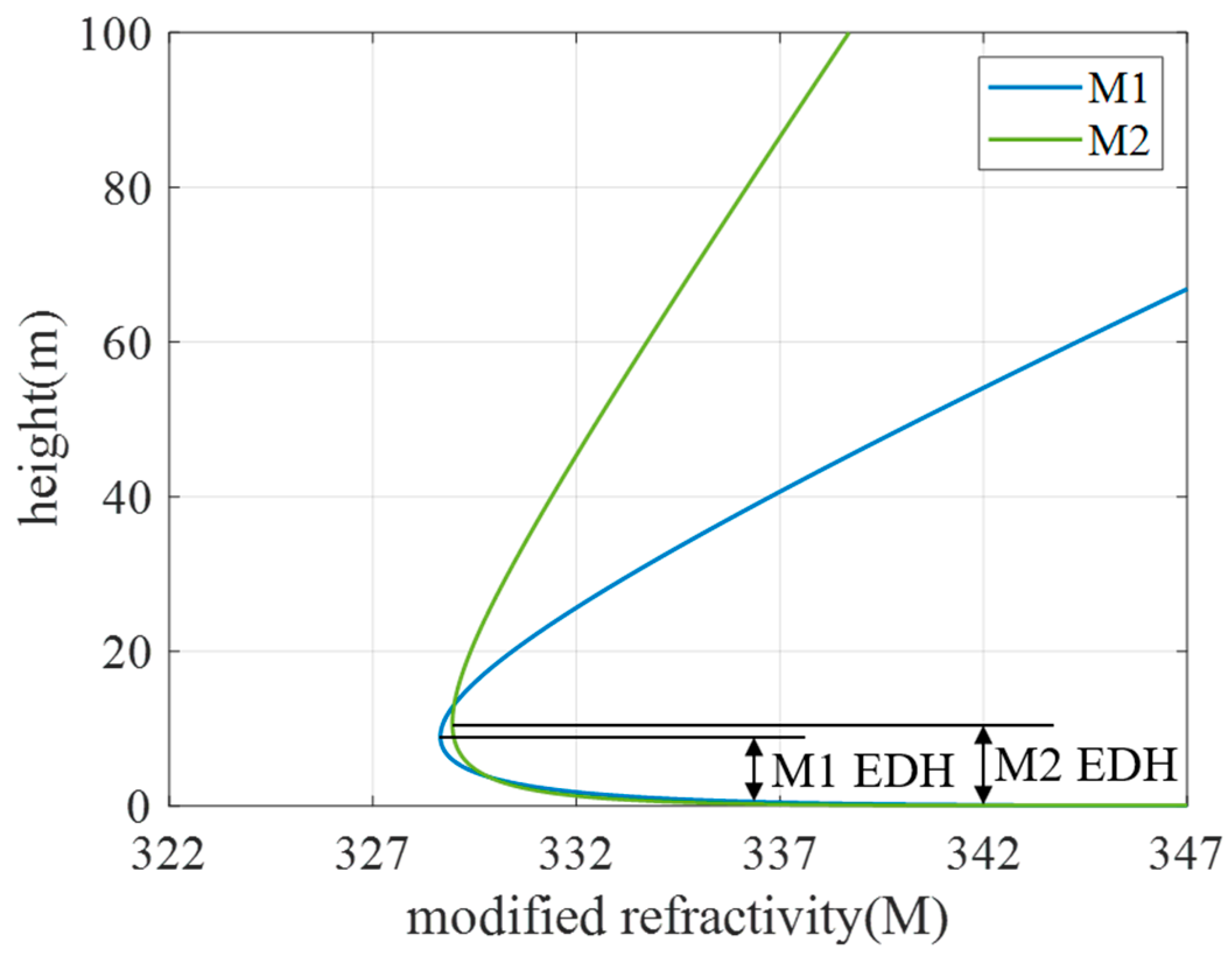
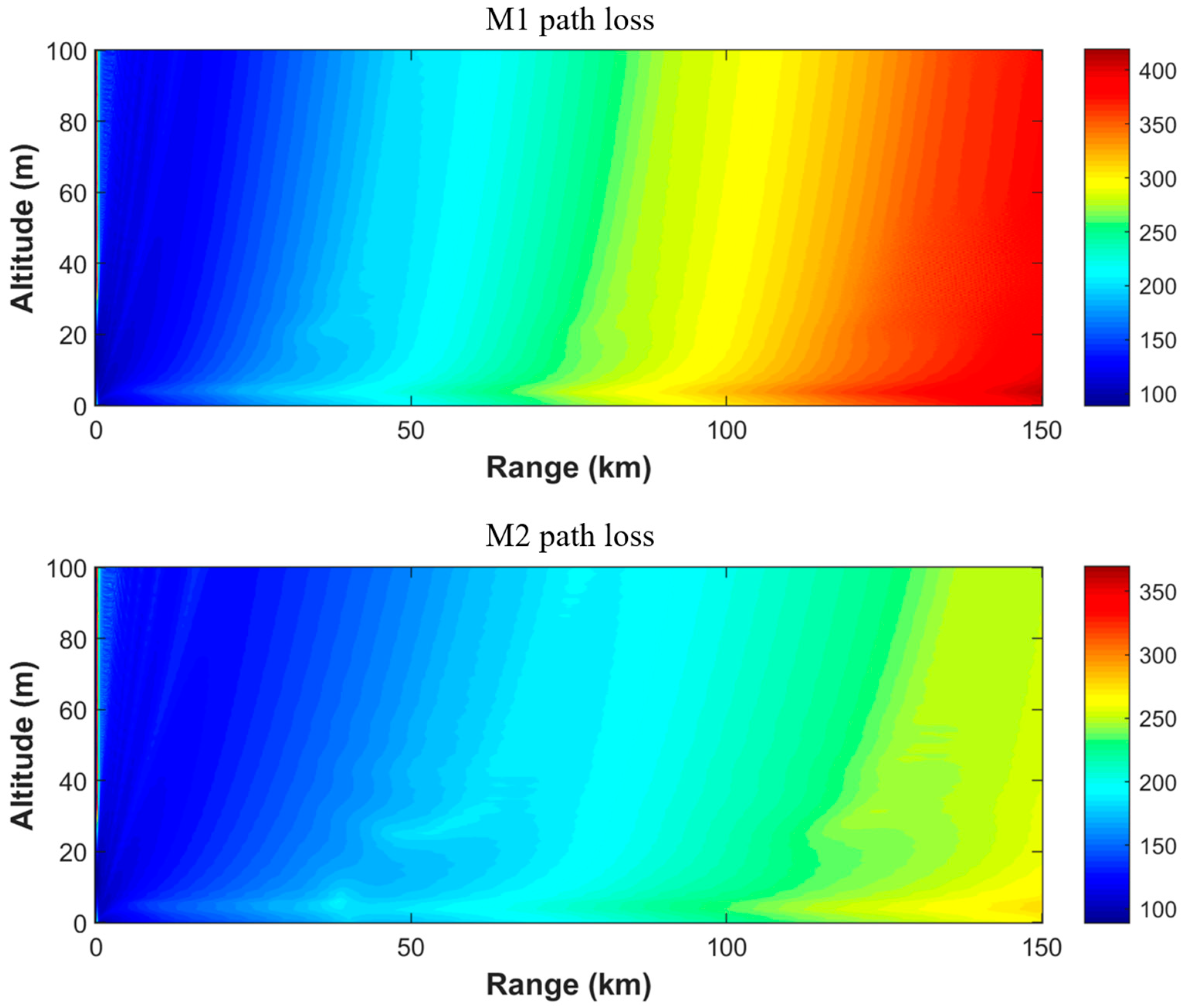

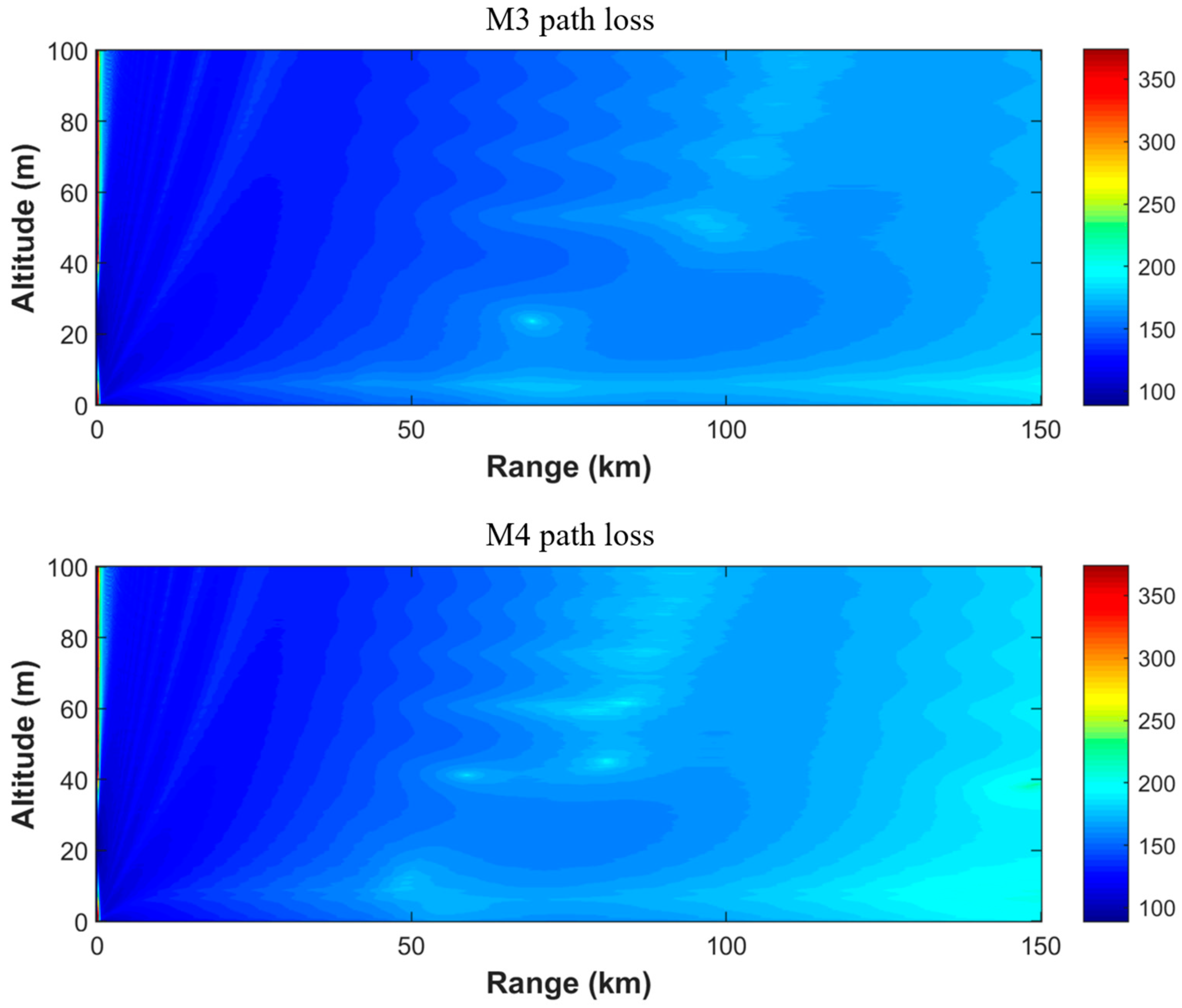
| Sensor | Model | Specification | Location | Quantity |
|---|---|---|---|---|
| Humidity and Temperature sensor | Vaisala HMP155 | RH: ±1% (15–25 °C, 0–90%RH); ±1.7% (20–40 °C, 90–100%RH) | Mast 3rd level | |
| Mast 1st level | ||||
| Compass deck | 5 | |||
| AT: ±(0.055–0.0057 × AT °C) | Accommodation deck | |||
| Forecastle deck | ||||
| Barometer | Young 61302L | ±0.2 hPa (25 °C, ±0.3 hPa (–40–60 °C) | Compass deck | 1 |
| Weather station | AIRMAR 150WXS | 5% (10 m/s) | Compass deck | 2 |
| Infrared thermometers | Optris CTLT20 | ±1 °C | Compass deck | 5 |
| Parameter to Optimize | Numeric Range | Parameter to Optimize | Numeric Range |
|---|---|---|---|
| a in | [800–1500] | b in | [4–5] |
| c in | [3.5–7.5] | d in | [0.3–1] |
| in | [1–10] | in | [0.1–0.5] |
| in | [1–10] | in | [3–10] |
| in and | [1–30] | in and | [0.1–0.5] |
| Function | Improvement for Stable Conditions | Improvement for Unstable Conditions | ||
|---|---|---|---|---|
| PSO | SA | PSO | SA | |
| only | 0.51% | 0.51% | 0.70% | 0.70% |
| only | 0.69% | 0.69% | 0.65% | 0.65% |
| only | 2.46% | 2.46% | 2.81% | 2.81% |
| only | 2.66% | 2.66% | 9.74% | 9.74% |
| 3.00% | 2.97% | 2.97% | 2.96% | |
| 3.11% | 3.09% | 9.84% | 9.84% | |
| 5.09% | 4.75% | 9.97% | 9.89% | |
| Function | Improvement for Stable Conditions | Improvement for Unstable Conditions | ||
|---|---|---|---|---|
| PSO | SA | PSO | SA | |
| only | 0.95% | 0.95% | 0.74% | 0.74% |
| only | 2.24% | 2.24% | 0.47% | 0.47% |
| only | 2.46% | 2.46% | 4.27% | 4.27% |
| only | 0.38% | 0.38% | 11.18% | 11.20% |
| 3.58% | 3.53% | 4.04% | 4.28% | |
| 2.20% | 1.43% | 11.15% | 11.15% | |
| 13.40% | 14.11% | 11.37% | 11.08% | |
Disclaimer/Publisher’s Note: The statements, opinions and data contained in all publications are solely those of the individual author(s) and contributor(s) and not of MDPI and/or the editor(s). MDPI and/or the editor(s) disclaim responsibility for any injury to people or property resulting from any ideas, methods, instructions or products referred to in the content. |
© 2024 by the authors. Licensee MDPI, Basel, Switzerland. This article is an open access article distributed under the terms and conditions of the Creative Commons Attribution (CC BY) license (https://creativecommons.org/licenses/by/4.0/).
Share and Cite
Cui, Y.; Hu, T.; Qi, K.; Qiu, Z.; Zou, J.; Li, Z.; Wang, B. Research on Optimization Method of Evaporation Duct Prediction Model. Mathematics 2024, 12, 205. https://doi.org/10.3390/math12020205
Cui Y, Hu T, Qi K, Qiu Z, Zou J, Li Z, Wang B. Research on Optimization Method of Evaporation Duct Prediction Model. Mathematics. 2024; 12(2):205. https://doi.org/10.3390/math12020205
Chicago/Turabian StyleCui, Yingxue, Tong Hu, Ke Qi, Zhijin Qiu, Jing Zou, Zhiqian Li, and Bo Wang. 2024. "Research on Optimization Method of Evaporation Duct Prediction Model" Mathematics 12, no. 2: 205. https://doi.org/10.3390/math12020205





